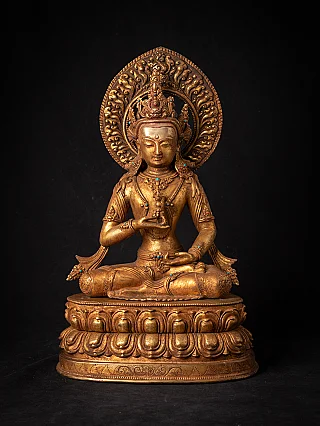Vajrayogini - Ugra Tara
Author : Peter Vredeveld

In the Buddhist world, Vajrayogini is a Hindu goddess of knowledge and wisdom, also known as Ugra Tara.
Visit our Hindu God Statues collection
Vajrayogini is a Hindu goddess of knowledge and wisdom in the Buddhist world, also known as Ugra Tara. Therefore, the goddess is equally sacred to both the Hindus and Buddhists. The name Vajrayogini suggests a close association with Tantric beliefs of Vajrayana Buddhism. Bajra, or Vajra, is the Buddhist symbol of thunder and lightning. Therefore, the wielder of Vajra is named as Vajrayogini. The tantric beliefs, developed as a synthesis of ancient pre-Hindu religions and new ideas, rejected many orthodox Hindu and Buddhist beliefs. Therefore, the tantric believers brought out a Jogini as the female counterpart to a Bhairab, the angered or wrathful form of Lord Shiva. Therefore, Vajrayogini can be termed as the wrathful form of Shiva's partner Mahadevi or Parvati holding a Vajra but in a more peaceful manifestation. A parallel development in Buddhism is that the goddess Vajrayogini is the female counterpart of the Dhyani Buddhas.
The goddess Vajrayogini is believed to be one of the wisest and strongest deities who can grant the gift of superior enlightenment to anyone she thinks deserves it. Society influences Buddhism in Nepal itself. As there are many instances of development of the shaktis of the female consorts, which were and are still widely popular in the Kathmandu valley, these shaktis sometimes overshadow entirely their male counterparts, especially in Tantric belief.
Origin and Lineage
The origins of Vajrayogini trace back to ancient tantric traditions, where she symbolizes the union of wisdom and compassion. In Hinduism, she is often associated with the fierce aspect of the divine feminine, representing the transformative force that destroys ignorance and leads to enlightenment.
Iconography and Symbolism
Vajrayogini's iconography is rich in symbolism. Her red color symbolizes her fierce compassion, while her three eyes represent her ability to see past, present, and future. The Vajra she holds signifies her unshakable determination to guide devotees towards spiritual awakening.
Etymology and Epithets
The name "Vajrayogini" carries profound meaning. "Vajra" signifies indestructibility and enlightenment, while "Yogini" represents spiritual practice and transformation. She is also known by various epithets such as "Ugra Tara" and "Mahadevi," highlighting different aspects of her divine nature.
Mythological Origin
There is a fascinating story about the origins of the goddess Vajrayogini in a holy book, which was discovered a long time ago. According to the book, the rest of the world was covered in snow, and before long, there emerged a five-colored flame, which came to be the volcanic goddess. The goddess's emergency site was then used for a temple to be built under her command. The priests have used the nine surrounding caves to serve this temple for centuries. The first priest to serve the temple, Gyanacharya Yogi, who did penance in the cave, was given superior enlightenment.
Vajrayogini Temples
Vajrayogini temples, dedicated to the worship of the goddess, are sacred sites of pilgrimage and devotion. These temples serve as focal points for spiritual practice and community gatherings, where devotees come to seek guidance and blessings from Vajrayogini.
Vajrayogini Temple - Sankhu
A temple dedicated to the goddess Vajrayogini is at Sankhu in Kathmandu, Nepal. It is also well known as Bodhisattva's Temple. The temple is a temple complex, with King Pratap Malla building the main temple in the sixteenth century. The Vajrayogini temple is situated about 20 kilometers northeast of the capital Kathmandu. The area surrounding the temple is often called Gunbaha, meaning 'recreational forest place' in Newari. The main temple is a three-storied pagoda building constructed carefully with the utmost attention to detail. The statue of the goddess Vajrayogini is located inside the temple. The statue features a red face (hence the name Hyangu Khwaa Maaju, meaning Red-faced mother in the Newari Language with three eyes. The goddess's hands have her thumb and middle finger carefully decorated.
The hilltop, on which the temple is located, is accessed by a very long carved stone stairway. The site is richly covered with Newari architectural metalwork, carved wood details, and ancient artifacts like stone taps and Buddha statues. Including a small Buddhist stupa claimed to pre-date the Shakyamuni Buddha.
Sankhu Vajrayogini Temple after devastating Earthquake 2015
The Earthquake that hit Nepal (epicenter being Barpak and Sindhupalchowk) on April 25th, 2015, is one of the most devastating earthquakes in the history of Nepal. Thousands of people lost their lives, and the Earthquake destroyed central architecture and cultural heritage sites. Destruction of this temple was not an exception.
This temple is believed to have been built around 300 years ago. The strong Earthquake destroyed the temple, and it was forced to stand with the support of metal and wooden poles. It was declared unsafe, and restoration and rebuilding should be considered soon. Sankhu Reconstruction Committee and Locals / Volunteers have been looking after the affected areas' restoration, preservation, and rebuilding activities. All associated members have been given various responsibilities, such as collecting artifacts, timber, sanghas (decorated wooden windows), and personal belongings. The Earthquake caused unnecessary and unavoidable Destruction; temples, ponds, pagodas, and buildings were demolished.
Share this page














































